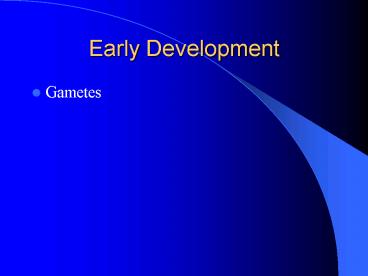Early Development - PowerPoint PPT Presentation
1 / 88
Title:
Early Development
Description:
Vegetal Pole yolk region. Animal Pole relatively yolk ... Biceps muscle. Notochord. Brain. Kidney. Spinal cord. Skin. Gastrulation in Macrolecithal eggs ... – PowerPoint PPT presentation
Number of Views:459
Avg rating:3.0/5.0
Title: Early Development
1
Early Development
- Gametes
2
Sperm
3
Egg
- Lecithal Yolk
4
Microlecithal egg
- Small amount of yolk
- Amphioxus
- Eutherians
5
Mesolecithal egg
- Medium amount of yolk
- Amphibians
6
Macrolecithal egg
- Large amount of yolk
- Bird and reptiles
- Most fish
7
Isolecithal
- Even yolk distribution
- In microlecithal eggs
8
Telolecithal
- Uneven yolk distribution
- Macrolecithal and Mesolecithal eggs
- Vegetal Pole yolk region
- Animal Pole relatively yolk-free, high
metabolic activity/embryo
9
Amniote eggs
Amnion
Allantoic cavity
Amnionic cavity
Allantois
Albumin
Chorion
Yolk
10
Layers around egg
- Vitelline membrane
- Jelly
- Capsule
- Shell
- Albumin
- Corona Radiata
- Zonal Pellucida
11
Oviparous
12
Viviparous
13
Ovoviviparous
14
Fertilization
15
Internal Fertilization
- Apodans
- Urodeles
- Amniotes
16
External Fertilization
- Fish
- Frogs
17
Zygote
18
Cleavage BlastulaMicrolecithal Eggs
- Cleavage Mitosis divisions
- Blastomeres
- Blastocoel
19
(No Transcript)
20
(No Transcript)
21
Cleavage Blastula
- Blastocyst in mammals
- Inner cell mass in mammals
- Trophoblast cells in mammals
22
(No Transcript)
23
(No Transcript)
24
Cleavage BlastulaMesolecithal eggs
25
(No Transcript)
26
(No Transcript)
27
Cleavage BlastulaMacrolecithal Eggs
- Blastoderm
- Blastocoel
28
(No Transcript)
29
(No Transcript)
30
Gastrulation
- Germ layers form from which ALL future organs
form - Notochord forms
- Bilateral symmetry established
31
Gastrulation/Microlecithal eggs
- Involution
- Blastopore
- Archenteron
32
(No Transcript)
33
Germ layers
- Ectoderm outer layer
- Mesoderm middle layer
- Forms notochord
- Splits to form coelom
- Endoderm inner layer around archenteron
34
GastrulationMesolecithal eggs
- Epiboly
35
(No Transcript)
36
Ectoderm
- Nervous System
- Sensory structures
- Neural crest cells that become melanocytes,
adrenal gland - Epidermis of skin
- Epithelium of mouth/nose and anus
37
(No Transcript)
38
(No Transcript)
39
Endoderm
- Lungs Swim bladders
- Digestive viscera
40
(No Transcript)
41
(No Transcript)
42
Mesoderm
- Chordomesoderm becomes notochord
43
(No Transcript)
44
Mesoderm
- Dorsal Mesoderm Epimere
- Segmented bands called somites
- Divides into
- Dermatome
- Myotome
- Sclerotome
45
(No Transcript)
46
(No Transcript)
47
(No Transcript)
48
Mesoderm
- Lateral plate mesoderm hypomere
- Splits into Somatic and Splanchnic layers
- Coelom between these layers
49
(No Transcript)
50
Hypomere
- Somatic Mesoderm plus Ectoderm
- Somatopleure
- Splanchnic Mesoderm plus Endoderm
- Splanchnopleure
51
(No Transcript)
52
Mesoderm
- Intermediate mesoderm Mesomere
- Kidney tubules and associated ducts
53
(No Transcript)
54
(No Transcript)
55
Key Points
- Which germ layer (ectoderm, endoderm, mesoderm)
gives rise to the following structures - Heart
- Liver
- Lung
- Biceps muscle
- Notochord
- Brain
- Kidney
- Spinal cord
- Skin
56
Gastrulation in Macrolecithal eggs
- Delamination
- Blastoderm forms upper sheet of cells called
Epiblast and - Lower sheet of cells called Hypoblast
- Epiblast becomes Ectoderm
- Hypoblast becomes Endoderm
57
(No Transcript)
58
(No Transcript)
59
Gastrulation in Macrolecithal eggs
- Mesoderm forms by Primitive Streak
- Cells stream inward from posterior to anterior
- Gives rise to notochord
60
(No Transcript)
61
(No Transcript)
62
(No Transcript)
63
(No Transcript)
64
Gastrulation in macrolecithal eggs
- Some mesoderm is unorganized and migrates, called
MESENCHYME
65
Gastrulation in macrolecithal eggs
- Body stalk
- Connection from body to yolk
66
(No Transcript)
67
(No Transcript)
68
Gastrulation in mammal
- Blastoderm
- Delamination to form hypoblast epiblast
- Primitive streak forms mesoderm
- Notochord
- Mesenchyme
- Coelom from splitting of lateral plate mesoderm
69
(No Transcript)
70
(No Transcript)
71
Neurulation
- Dorsal hollow nerve cord
- Neural crest cells branch off
72
(No Transcript)
73
(No Transcript)
74
Organogenesis
- Beginning of all major organs of the body
75
Extraembryonic membranes
- Fish
- Body stalk
- Yolk sac
76
- Amphibians
77
Extraembryonic membranes
- AMNIOTES
- Yolk sac (from splanchnopleure)
78
(No Transcript)
79
(No Transcript)
80
Amniotes
- Amnion
- From somatopleure
- Amniotic Fluid
81
(No Transcript)
82
(No Transcript)
83
Amniotes
- Chorion
- From somatopleure
- For communication with oxygen source
- Helps form placenta in mammals
- Against shell in birds
84
(No Transcript)
85
Amniotes
- Allantois
- From splanchnopleure
- Gas exchange in reptiles
- Waste receptacle in eutherians
86
(No Transcript)
87
(No Transcript)
88
Placenta in Eutherians
- Excellent waste removal nutrient uptake
- Moms uterus plus babys extraembryonic membrane
- Attaches to baby via umbilical cord
- Yolk sac functions as placenta in marsupials































